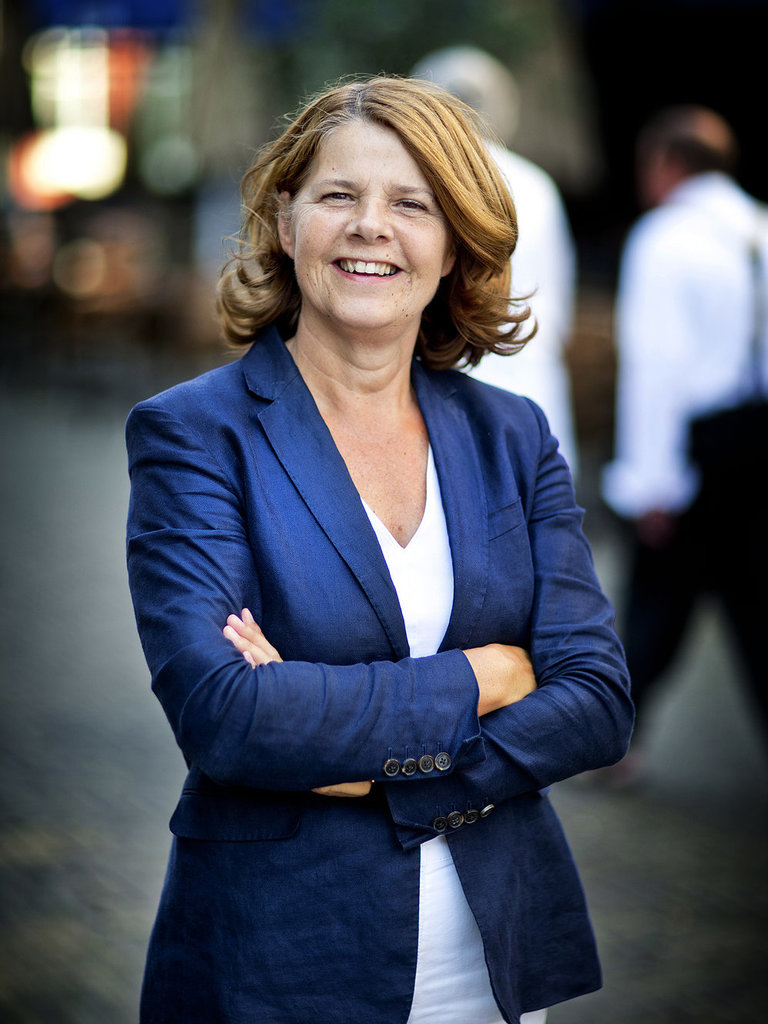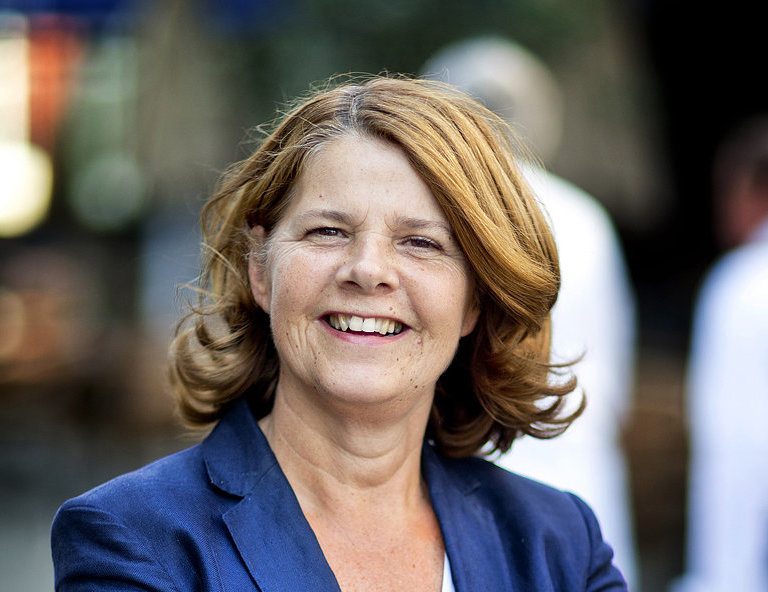
“Our connection is through the people”
Mayor Marja van Bijsterveldt talks about the collaboration with TU Delft
What impact does TU Delft have on the city of Delft? How do the municipality and the University collaborate? The Mayor of Delft, Marja van Bijsterveldt, gave an interesting speech on this topic during the Impact Festival (Impactfestival) of the Association of Universities in the Netherlands (VSNU) in November last year.
By: Marja van Bijsterveldt
Collaborating with the University and science - or rather with people from the University and the field of science - how do we do it in Delft? I promise to give a very short answer to this question. But I will start (I’m a politician, after all) with the somewhat longer version.
In Delft, we work together with TU Delft in many areas. Together we develop the area in and around the TU campus. We work jointly on a form of economic development of Delft that taps into the strengths of Delft: robotics, quantum, circular. Together we want to connect various groups of people living in Delft - students and scientists, ‘ordinary’ Delftians as well as those who may need extra attention. In the course of the past year, we have set out the agreements relating to our collaboration in a covenant.
But to have such an intensive collaboration between a university and the city: is that really possible, aren’t they two very different worlds? It’s true, it hasn't exactly been straightforward till now. After all, by its very nature a university is more international, more globally oriented, whereas a municipality will be locally oriented. A university focuses on the technology of tomorrow to solve the problems of the day-after-tomorrow, while as a municipality you mostly seem to be dealing with the business of the day.
Strongly connected
And yet: the city and TU Delft are strongly connected to one another. We also need each other, and we believe in shared tasks: ensuring a pleasant living environment and comfortable housing for citizens as well as for students and scientists, and creating a liveable city where everyone feels good, an accessible campus and an active, bustling city that capitalises on our strengths.
Delft has a population of just over 100,000 and is home to over 30,000 students from TU Delft and the two universities of applied sciences. About 20,000 of these students also live in Delft. The higher-education footprint and especially that of TU Delft is, therefore, considerable. In addition, with 5,000 employees TU Delft is the largest employer in Delft. Our connection is through the people: all the students, teachers and scientists are also Delftians. They are all part of the Delft community.
When it comes to complex construction projects, we rely on our experts at TU Delft. For example, if a rail tunnel has to be excavated. In soft soil. With a high groundwater level. We also want to create a completely new neighbourhood called ‘Nieuw Delft’. For this, TU Architecture & Built Environment will give advice, incorporate the project into its study programmes and use the site as a research area. For example, to monitor the effects of the construction process in detail.
The City Deal is good for the city, because the available knowledge is used to jointly create a better version of the city
Marja van Bijsterveldt, Mayor of Delft
City Deal on Education
TU Delft is also involved in the City Deal on Education (City Deal Kennis Maken). This deal is a joint effort of 10 university cities, universities, universities of applied sciences, the Ministry of Education, Culture and Science and the Ministry of the Interior and Kingdom Relations. The initial idea for this deal can be traced back to the Network of Dutch Knowledge-oriented Cities (Netwerk Kennissteden Nederland). The question asked by this network was: how can we solve social issues more quickly? The answer to this question was: by involving researchers, teachers and students in this effort. That's the City Deal in a nutshell. A win-win situation.
The City Deal is good for the city, because the available knowledge is used to jointly create a better version of the city. At the same time, the City Deal enriches education by presenting the city as a living lab, a ‘lecture hall’ or ‘practical lab’ for the students, thereby contributing to educational innovation. It also offers room for other talents to flourish, such as entrepreneurship. And it creates a link between knowledge and social involvement.
Social challenges
Acquiring knowledge for the sake of knowledge - not because we must but because we can - where’s the value in that? For me, knowledge becomes really valuable and useful when it connects with social challenges. It is good for students to start thinking about this already: ‘What can I actually do with the knowledge I have, what value can I add?’ After all, they are being trained for a job in the future, a job that often does not even exist today.
The City Deal helps students by making them more aware of how they can utilise their professional knowledge and skills. It helps students to establish that link between technology, knowledge and social challenges. That’s also what students want to do: contribute something meaningful to society through their knowledge. Today’s student doesn’t just want to get rich through technology, they also want to add value.
Adding value to the city
Collaboration between universities and the city helps to add value to the city. To make this better version of the city happen as a collaborative effort. That is only possible in an undivided city. Concerns about the increasing divide between people, or as Kim Putters of the Netherlands Institute for Social Research (SCP) aptly puts it ‘between the cans and cannots’, are stronger in Delft than in the average city.
In Delft, we have this world of knowledge on the one hand: a world where it all seems to be happening, where young students can easily get involved in the dynamics of lightning-fast technological developments. A group for whom every change represents a new opportunity, a new inspiring challenge.
However, Delft also has groups of people who are not or are barely aware of these developments. Who feel that they are just not part of this dynamic world of progress. Those who see the old certainties, on which their existence was based, rapidly disappearing. There is a high risk of such people feeling alienated and simply dropping out of society.
Currently, we have about 3,000 functionally illiterate people in Delft, the ‘City of Knowledge’. That is why, at the start of the renewed collaboration with TU Delft, I insisted that the connection between the various communities within the city and the University should also be included on the agenda.
We work together to create that better version of our city. And the city becomes part of the students’ curriculum.
Marja van Bijsterveldt, Mayor of Delft
Undivided city
Fortunately, we are gradually seeing many wonderful initiatives unfold within our city. For example, the TU Delft Honours Programme is challenging students to apply their knowledge of leadership to addressing problems in our most vulnerable neighbourhoods. In addition, students and student associations are organising themselves to do valuable volunteer work in various areas. In the interests of an undivided city, but also in the interests of the young people themselves, we want to scale up this commitment over the coming years. To ensure that they become good leaders in the positions they will hold in the future and that they have at least made an attempt to look beyond their own, often very comfortable, bubble.
The efforts made by students and scientists in terms of achieving local social objectives are wider in scope: closer to the study programme itself, enabling people to live independently at home longer with the help of technology or providing assistance to healthcare professionals in the operating theatre via DORA (Digital Operating Room Assistant), a digital OT assistant. DORA checks and double-checks the safety and quality of the medical equipment in the OT, so that the professionals can fully focus on complicated medical interventions. Reinier de Graaf Hospital in Delft, which has recently reached a much higher ranking (not entirely by coincidence) among the top hospitals in the Netherlands, is the first hospital to start working with DORA. DORA can assist with all surgical procedures.
Better version of our city
So this was the longer version of the answer to the question of how we collaborate with people from the University and the field of science. To summarise, the short answer is: to everyone’s satisfaction.
The covenant and the City Deal give our collaboration a sustainable structure. We work together to create that better version of our city. And the city becomes part of the students’ curriculum - and it is just a matter of time till each student graduates with honours in Delft.
Or in another city, which is also equally commendable. I have only referred to technology and science initiatives, but if the Mayor of Leiden had been here, he would undoubtedly have provided fine examples of how Arts and Social Sciences students contribute to a better version of Leiden. Numerous examples of similarly meaningful collaborations with universities can be found in the Netherlands.
Opportunities for a strong city, opportunities for strong education, opportunities for strong leadership for the future!
Marja van Bijsterveldt, Mayor of Delft
SmartPort Rotterdam
As Vice-Chair of the Supervisory Board of the Erasmus University, I am especially proud of two outstanding examples of collaboration. One of them is the collaboration between Erasmus, TU Delft and the Rotterdam business community on the SmartPort Rotterdam project. Together, the parties are committed to transforming the Port of Rotterdam into the Smartest Port in 2030, i.e. the most sustainable and intelligent port in the world. The driving force behind this is joint demand-driven research and the desire to make a significant impact in SmartPort's five focus areas, known as the 'Roadmaps'. These five Roadmaps revolve around the themes of Smart Logistics, Future-proof Port Infrastructure, Smart Energy and Industry, World Port City and Port Strategy.
The second example relates to wonderful community projects in which medical students work with the Public Health Service of Amsterdam (GGD) or the Erasmus Governance Design Studio, under the Public Administration study programme where students design a plan for the self-management of green areas in neighbourhoods.
Golden opportunity
In short, opportunities galore! For the university cities, the universities represent a golden opportunity. Besides all this knowledge, it is also all the energy from those young people in our universities that offers amazing opportunities. Opportunities for a strong city, opportunities for strong education, opportunities for strong leadership for the future!
